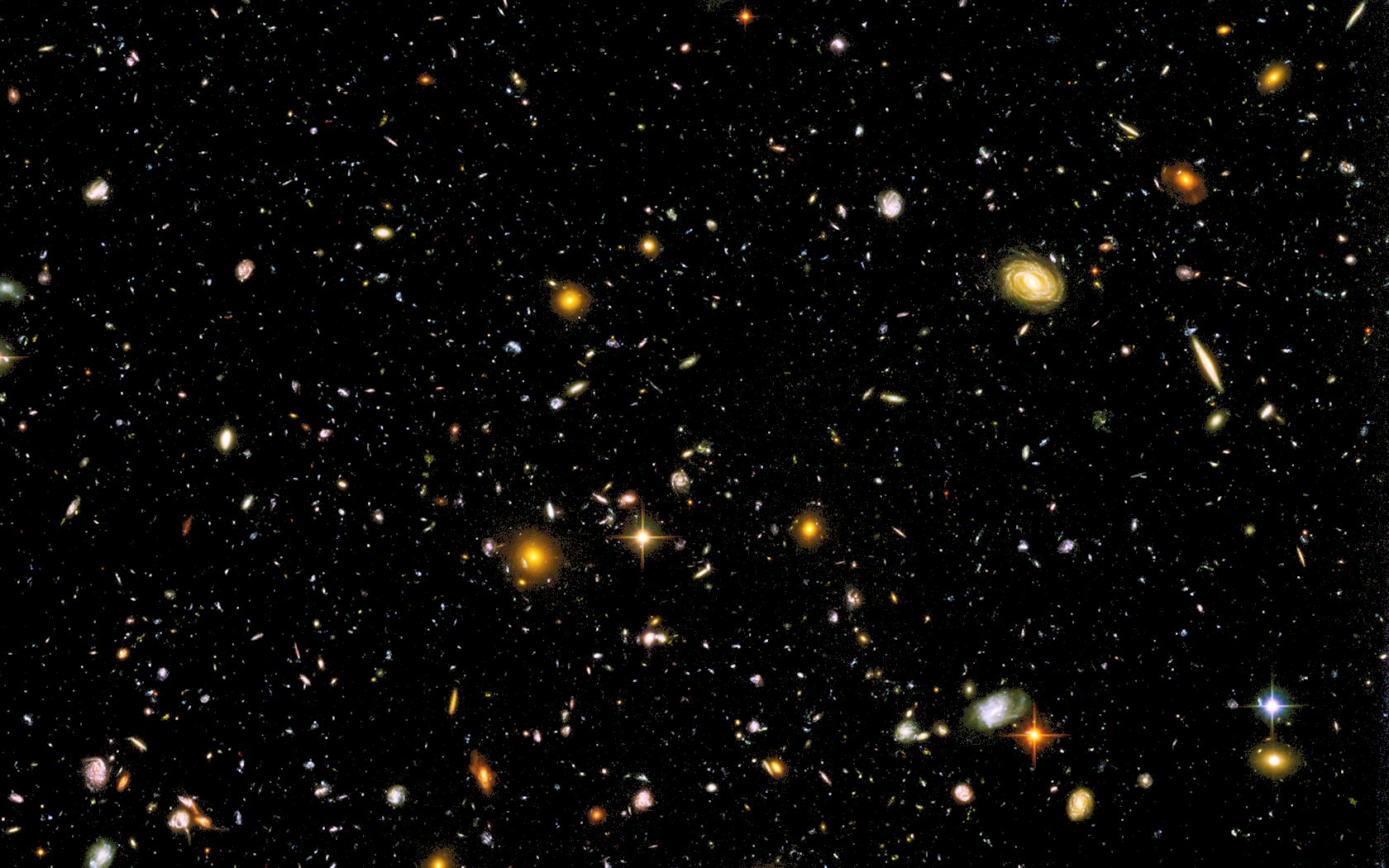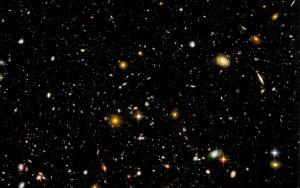I came across an article today entitled, “The Astounding Truth About the Hubble Space Telescope’s Most Famous Image.” In it was an image pretty much like this one. We learn in the piece that:
The specks of color and light you see are not stars; they are galaxies — 10,000 of them in fact! It is the deepest image of the sky over obtained, gazing back approximately 13 billion years.
You might be thinking as I was, 10,000 galaxies! That’s a lot of galaxies! We’re not talking stars, or solar systems; we’re talking 10,000 Milky Ways! And our galaxy isn’t a small place. In fact, it’s 100,000 to 120,000 light years in diameter, and one light year is six trillion miles! Is your brain scrambled yet? Well, that isn’t even the one-forty millionth of it!
“The image is only one-forty millionth of the sky. In other words, it would take 40 million Hubble Ultra-Deep Fields to cover the entire sky,” Dr. Edward J. Weiler, former Chief Scientist for the Hubble Space Telescope, recently revealed in a presentation at the Smithsonian National Air and Space Museum in Washington, D.C. “If you wanted a human analogy, go out on a clear night, get a standard sewing needle, hold it up at arms’ length and look at the hole in the sewing needle. That’s the size of the sky you’re seeing portrayed here.”
OK, can we say incomprehensible? The 10,000 galaxies are only what you can see through the hole in the needle! Then you have the rest of the universe to go. The author rightly calls the Hubble images, “sights of unimaginable beauty, radiant majesty, and awesome stellar violence.” More than that, the images reflect the handiwork of a creator who is incomprehensibly greater, more beautiful and majestic that what he has made. And all of it reveals him to us. As the Apostle Paul says in Romans 1:
. . . since what may be known about God is plain to them, because God has made it plain to them. For since the creation of the world God’s invisible qualities—his eternal power and divine nature—have been clearly seen, being understood from what has been made . . .
Paul may have had in mind what David said in Psalm 19 when he wrote this;
1 The heavens declare the glory of God;
the skies proclaim the work of his hands.
2 Day after day they pour forth speech;
night after night they reveal knowledge.
3 They have no speech, they use no words;
no sound is heard from them.
4 Yet their voice goes out into all the earth,
their words to the ends of the world.
And this was 1,000 years before Christ! There was no what we’ve come to call light pollution in the ancient world. David was a shepherd in his early days, so the magnificence of the night sky and God’s power was apparent to him even before modern science had blown our mind. If you live in a city with lots of light pollution it just isn’t the same. I remember when I was much younger going to Lake Tahoe in northern California with my family. I would sit under the stars every night transfixed; it seemed I could almost touch them. Later when I was in college at Arizona State University, I would travel back and forth between LA and school on I10. I would pull off the highway from time to time in the middle of nowhere just to gaze up at the innumerable stars. Little did I know just how innumerable they actually were!
 What Hubble has done for our knowledge, along with many other scientific discoveries, has begun to create a seismic paradigm shift in our modern/postmodern world. Since the beginning of the Enlightenment in the late 17th Century, skeptics have used science to attack religion. At the apex of the Newtonian worldview in the 19th Century where nature appeared simple, mechanical and perfectly predictable, God became something of an implausible character to Western cultural elites. That same century gave us Darwin, Marx, Freud and Nietzsche, the latter who really did believe we had effectively killed God. The others gave us a creation story that made God optional, a theory of economic and historical determinism that took God off of any throne he might have occupied previously, and the other a psychology to explain this crazy thing we call humanity.
What Hubble has done for our knowledge, along with many other scientific discoveries, has begun to create a seismic paradigm shift in our modern/postmodern world. Since the beginning of the Enlightenment in the late 17th Century, skeptics have used science to attack religion. At the apex of the Newtonian worldview in the 19th Century where nature appeared simple, mechanical and perfectly predictable, God became something of an implausible character to Western cultural elites. That same century gave us Darwin, Marx, Freud and Nietzsche, the latter who really did believe we had effectively killed God. The others gave us a creation story that made God optional, a theory of economic and historical determinism that took God off of any throne he might have occupied previously, and the other a psychology to explain this crazy thing we call humanity.
Fortunately for the other 90 plus percent of humanity who need more than an accident to explain the universe, Einstein started to change all that in the early 20th Century with his general theory of relativity, published in 1915; nature isn’t so simple after all. And one hundred years later something funny has been happening on the way to God’s funeral: the knowledge science has given us is making a God-less universe appear less and less plausible. Author Eric Metaxas made exactly this case in a Wall Street Journal article last Christmas Day, “Science Increasingly Makes the Case for God.”
If you’ve ever read through the Bible from cover to cover as I have a couple times over the last handful of years, you might like me be sort of surprised how often God as creator comes up in the history of redemption. Surprise maybe isn’t the right word because of course it makes perfect sense if you read the first couple chapters of Genesis. But God as creator in the Old Testament is always contrasted with the gods and the idols of the nations around the Hebrews, who are in fact nothing, we are told over and over again. So it shouldn’t surprise us that not only did God create a discoverable universe that reveals him so clearly and obviously, but that these creatures he created in his image can actually discover him in it! Or it could all just be one gigantic cosmic accident, one very amazing coincidence. Now that is implausible!


